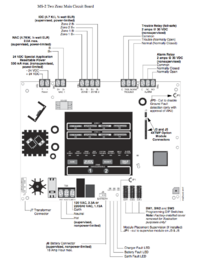Conventional Fire Alarm Panels
Though lesser used now, conventional panels are very simple. There are two main circuits to focus on, the IDC, and the NAC. When a device on the IDC (otherwise known as a zone), such as a pull station, causes a short circuit, the panel goes into a latching alarm and activates the NAC circuits. Similarly, when a smoke or rate of rise heat detector activates, this causes an increase of current forcing the panel into alarm.
Most conventional panels are very limited on programming. Some have programming for synchronization, setting zone types, or allowing different zones to activate different NACs, etc.. These features are really only seen on newer models of panels, but many older models don't have any programming at all, but rather have a simple "If there is a short circuit, make noise" setup using relays.
There are some newer conventional panels that has some of the functionality of an intelligent panel. Including an LCD, the ability to name zones, programmable relays, dialers with Contact ID, etc. But they still work the same way with IDC's and NAC's.
In the picture below, you may notice there are several other parts to a conventional panel. Relay's are included in this panel for different conditions - Fire and Trouble.


